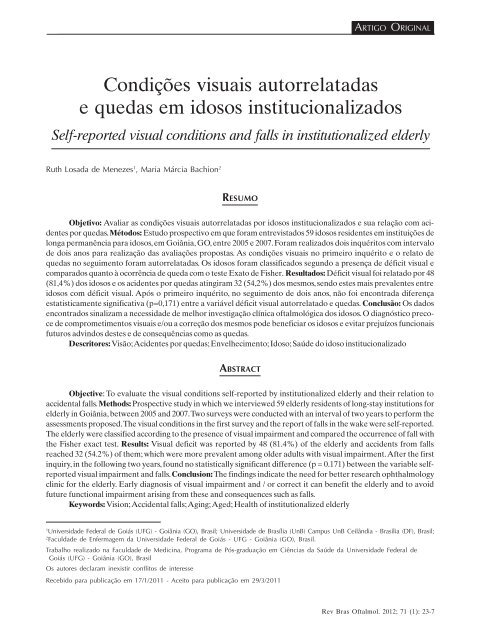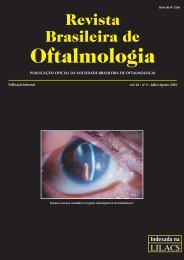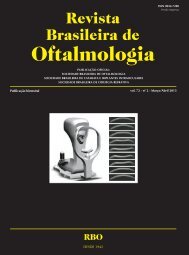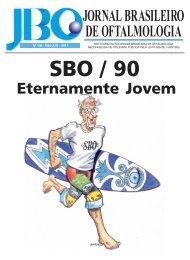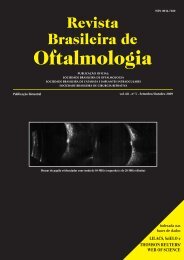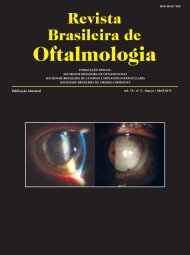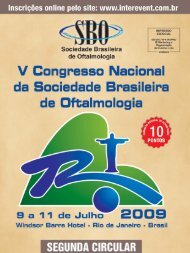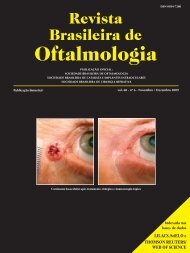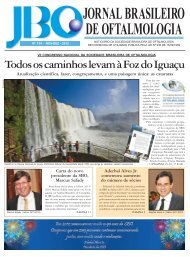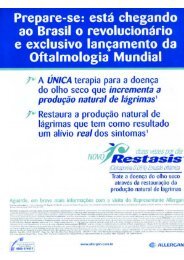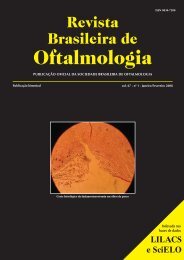Jan-Fev - Sociedade Brasileira de Oftalmologia
Jan-Fev - Sociedade Brasileira de Oftalmologia
Jan-Fev - Sociedade Brasileira de Oftalmologia
You also want an ePaper? Increase the reach of your titles
YUMPU automatically turns print PDFs into web optimized ePapers that Google loves.
ARTIGO ORIGINAL23<br />
Condições visuais autorrelatadas<br />
e quedas em idosos institucionalizados<br />
Self-reported visual conditions and falls in institutionalized el<strong>de</strong>rly<br />
Ruth Losada <strong>de</strong> Menezes 1 , Maria Márcia Bachion 2 RESUMO<br />
Objetivo: Avaliar as condições visuais autorrelatadas por idosos institucionalizados e sua relação com aci<strong>de</strong>ntes<br />
por quedas. Métodos: Estudo prospectivo em que foram entrevistados 59 idosos resi<strong>de</strong>ntes em instituições <strong>de</strong><br />
longa permanência para idosos, em Goiânia, GO, entre 2005 e 2007. Foram realizados dois inquéritos com intervalo<br />
<strong>de</strong> dois anos para realização das avaliações propostas. As condições visuais no primeiro inquérito e o relato <strong>de</strong><br />
quedas no seguimento foram autorrelatadas. Os idosos foram classificados segundo a presença <strong>de</strong> déficit visual e<br />
comparados quanto à ocorrência <strong>de</strong> queda com o teste Exato <strong>de</strong> Fisher. Resultados: Déficit visual foi relatado por 48<br />
(81,4%) dos idosos e os aci<strong>de</strong>ntes por quedas atingiram 32 (54,2%) dos mesmos, sendo estes mais prevalentes entre<br />
idosos com déficit visual. Após o primeiro inquérito, no seguimento <strong>de</strong> dois anos, não foi encontrada diferença<br />
estatisticamente significativa (p=0,171) entre a variável déficit visual autorrelatado e quedas. Conclusão: Os dados<br />
encontrados sinalizam a necessida<strong>de</strong> <strong>de</strong> melhor investigação clínica oftalmológica dos idosos. O diagnóstico precoce<br />
<strong>de</strong> comprometimentos visuais e/ou a correção dos mesmos po<strong>de</strong> beneficiar os idosos e evitar prejuízos funcionais<br />
futuros advindos <strong>de</strong>stes e <strong>de</strong> consequências como as quedas.<br />
Descritores: Visão; Aci<strong>de</strong>ntes por quedas; Envelhecimento; Idoso; Saú<strong>de</strong> do idoso institucionalizado<br />
ABSTRACT<br />
Objective: To evaluate the visual conditions self-reported by institutionalized el<strong>de</strong>rly and their relation to<br />
acci<strong>de</strong>ntal falls. Methods: Prospective study in which we interviewed 59 el<strong>de</strong>rly resi<strong>de</strong>nts of long-stay institutions for<br />
el<strong>de</strong>rly in Goiânia, between 2005 and 2007. Two surveys were conducted with an interval of two years to perform the<br />
assessments proposed. The visual conditions in the first survey and the report of falls in the wake were self-reported.<br />
The el<strong>de</strong>rly were classified according to the presence of visual impairment and compared the occurrence of fall with<br />
the Fisher exact test. Results: Visual <strong>de</strong>ficit was reported by 48 (81.4%) of the el<strong>de</strong>rly and acci<strong>de</strong>nts from falls<br />
reached 32 (54.2%) of them; which were more prevalent among ol<strong>de</strong>r adults with visual impairment. After the first<br />
inquiry, in the following two years, found no statistically significant difference (p = 0.171) between the variable selfreported<br />
visual impairment and falls. Conclusion: The findings indicate the need for better research ophthalmology<br />
clinic for the el<strong>de</strong>rly. Early diagnosis of visual impairment and / or correct it can benefit the el<strong>de</strong>rly and to avoid<br />
future functional impairment arising from these and consequences such as falls.<br />
Keywords: Vision; Acci<strong>de</strong>ntal falls; Aging; Aged; Health of institutionalized el<strong>de</strong>rly<br />
1<br />
Universida<strong>de</strong> Fe<strong>de</strong>ral <strong>de</strong> Goiás (UFG) - Goiânia (GO), Brasil; Universida<strong>de</strong> <strong>de</strong> Brasília (UnB) Campus UnB Ceilândia - Brasília (DF), Brasil;<br />
2<br />
Faculda<strong>de</strong> <strong>de</strong> Enfermagem da Universida<strong>de</strong> Fe<strong>de</strong>ral <strong>de</strong> Goiás - UFG - Goiânia (GO), Brasil.<br />
Trabalho realizado na Faculda<strong>de</strong> <strong>de</strong> Medicina, Programa <strong>de</strong> Pós-graduação em Ciências da Saú<strong>de</strong> da Universida<strong>de</strong> Fe<strong>de</strong>ral <strong>de</strong><br />
Goiás (UFG) - Goiânia (GO), Brasil<br />
Os autores <strong>de</strong>claram inexistir conflitos <strong>de</strong> interesse<br />
Recebido para publicação em 17/1/2011 - Aceito para publicação em 29/3/2011<br />
Rev Bras Oftalmol. 2012; 71 (1): 23-7


